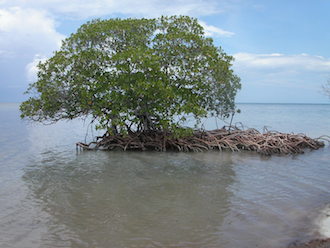THE threat came from a resident of Kutablang, Darul Makmur district, Nagan Raya regency, Aceh. “I will kill the orangutans if they return and eat the shoots of my oil palm trees,” he told Suratman and other activists from environmental foundation Yayasan Ekosistem Lestari (YEL).
Suratman, who assists YEL with their activities, told Tempo that the resident was irritated because some of his eight-year old oil palm trees had died. For that reason, the resident last Wednesday asked YEL foundation activists to drive away or capture the protected apes that until now have been living in the peat forest of Rawa Tripa.
Orangutans do frequently visit the local settlement and oil palm plantations, Sutarman said. Just the day before he had seen the animals in Merkati village. Along with offi cers from the Aceh Natural Resources Conservation Agency, YEL continues to provide guidance for villagers to prevent them from killing the animals.
In February last year, YEL found a baby orangutan in a critical condition in Sidojadi village. It seemed that its mother had been killed by locals. To rescue the young ape, YEL and the Conservation Agency moved six orangutans from the area to a pristine forest in Central Aceh over the period 2011-2012.
The Rawa Tripa peat forest, located in the Leuser Ecosystem Zone and bordering the Leuser National Park, is shrinking following the government licensing of oil palm companies to reclaim the land. In the early 1980s the peat area on the southwestern coast of Aceh covered no less than 62,000 hectares. Now its total area is no more than 17,000 hectares. The latest clearance was the opening of 1,605 hectares by oil palm company Kallista Alam.
This situation is obviously of grave concern, as the Leuser ecosystem serves as the habitat of tigers, elephants, rhinos and orangutans, which have been listed as endangered animals by the International Union for the Conservation of Nature (IUCN).
Science journal in its November 2013 issue mentioned the place as one of the world’s irreplaceable protected zones. “The Leuser Ecosystem provides countless environmental services, which are globally and locally important,” wrote Graham Usher, a Landscape Protection Specialist at the PanEco Foundation.
Ian Singleton, Director of the Sumatran Orangutan Conservation Program, explained that Rawa Tripa had been one of the three remaining peat swamp forests in Sumatra still inhabited by orangutans. “The population density of orangutans can reach eight per square kilometer in this area, compared to the average of only one or two per square kilometer of forests in other regions,” he said.
Tempo, visiting the peat land in July 2012 when it had already been reclaimed by Kallista Alam and Surya Panen Subur II, witnessed traces of forest burning. Kallista set up blocks on half of the 1,605 hectares of land. With heavy-duty equipment, canals were built to channel water into rivers. The same pattern was followed by seven other companies holding concessions in the Rawa Tripa zone.
The impact of the deforestation has now been felt by people in Darul Makmur and other districts. “When it rains even for a while, our settlement is inundated,” said Suratman, who lives in Sukarame village. In September, water fl owed into his house to a depth of 10 centimeters. Previously, he said, the village flooded only once in a year at the peak of the wet season. And even then, houses were not inundated.
Conversely, in the dry season clean water is hard to obtain. Water pumps generally used by residents with a drawing capacity of seven meters can no longer draw water. Inevitably, they have been forced to use jet pumps because the depth of wells comes to around 15 meters, Suratman said. Another adverse effect on residents is the loss of livelihoods. “Rawa Tripa’s catfish, once famous, are now difficult to find,” noted Suratman, born 46 years ago in Darul Makmur district.
He added that part of the land already cleared by Kallista Alam—and now disputed—is controlled by residents in five villages in Darul Makmur. Each village gets a maximum of two hectares to plant oil palms. YEL and other environmental activists once proposed that the land be made a conservation area. But the regional administration gave no response. Without outside help, they predict that the peat land and orangutans of Rawa Tripa will disappear in the next few years. Untung Widyanto
